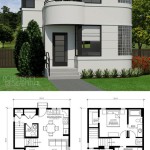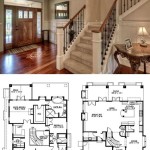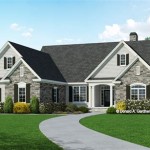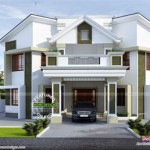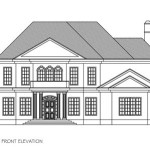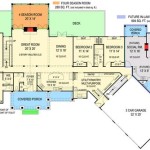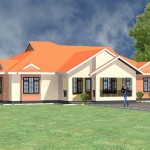Vacation House Floor Plans: Designing Your Dream Getaway
Vacation house floor plans play a crucial role in shaping the experience of a relaxing retreat. A well-designed plan maximizes space utilization, optimizes flow, and caters to the specific needs of vacationers, whether it's a cozy cabin for a couple or a sprawling beachfront villa for a large family. Careful consideration of factors like the number of bedrooms, common areas, outdoor living spaces, and storage solutions contribute to a comfortable and enjoyable vacation experience.
One of the initial considerations when selecting a vacation house floor plan is determining the desired size and layout. Square footage requirements are often dictated by the number of occupants and their intended use of the space. A studio or one-bedroom plan may suffice for a romantic getaway, while larger families may require multiple bedrooms and bathrooms. Open-plan layouts, often featuring a combined kitchen, dining, and living area, promote a sense of togetherness and facilitate interaction among guests. Conversely, compartmentalized plans can offer more privacy and individual space.
The location and landscape of the vacation property significantly influence floor plan design. Beachfront properties often incorporate large windows and expansive decks to maximize ocean views. Mountain cabins may feature vaulted ceilings and fireplaces to create a cozy ambiance. The surrounding terrain may also dictate the placement of entrances, windows, and outdoor living spaces. Incorporating the natural surroundings into the design helps to blur the lines between indoor and outdoor living, fostering a connection with nature.
The allocation of bedrooms and bathrooms warrants careful consideration. Master suites, often equipped with private bathrooms and walk-in closets, offer a luxurious retreat for adults. Guest bedrooms, depending on the intended occupants, may benefit from twin beds, bunk beds, or a combination thereof. Adequate bathroom facilities are essential, particularly for larger groups, and the strategic placement of bathrooms can minimize congestion and ensure privacy.
The design of common areas is crucial for fostering social interaction and creating a comfortable environment for guests. A spacious living room with ample seating provides a gathering place for relaxation and entertainment. A well-appointed kitchen, equipped with modern appliances and ample counter space, facilitates meal preparation and encourages communal dining. Dining areas, whether formal or informal, should comfortably accommodate all occupants. The inclusion of a dedicated game room or entertainment area can further enhance the vacation experience.
Outdoor living spaces are an integral part of many vacation house plans. Decks, patios, and balconies offer opportunities for al fresco dining, relaxation, and enjoyment of the surrounding scenery. The inclusion of a swimming pool, hot tub, or outdoor fireplace can further enhance the outdoor living experience. Careful consideration should be given to the orientation of outdoor spaces to maximize sun exposure or shade, depending on the climate and geographic location.
Storage solutions are often overlooked in vacation house plans, but they are essential for maintaining an organized and clutter-free environment. Adequate closet space in bedrooms, linen closets in hallways, and storage cabinets in the kitchen and bathrooms help to keep belongings organized and out of sight. The inclusion of a dedicated storage room or garage can provide space for larger items such as bicycles, kayaks, or beach gear.
Accessibility considerations are also important when designing a vacation house floor plan. Incorporating features such as ramps, wider doorways, and grab bars in bathrooms can make the property accessible to individuals with mobility impairments. These features not only enhance usability but also contribute to the long-term value and appeal of the property.
Budget is a significant factor that influences the design and construction of a vacation house. Construction costs vary depending on the size, complexity, and materials used. Working with an experienced architect and builder can help to ensure that the project stays within budget without compromising on quality or functionality. Careful planning and selection of cost-effective materials can help to optimize the budget without sacrificing design aesthetics or structural integrity.
Sustainability is an increasingly important consideration in vacation house design. Incorporating energy-efficient appliances, windows, and insulation can help to reduce energy consumption and operating costs. Utilizing sustainable building materials, such as reclaimed wood or bamboo, further minimizes the environmental impact. Designing for passive solar heating and cooling can also reduce reliance on conventional energy sources.
Local building codes and regulations play a vital role in shaping the design and construction of vacation houses. Zoning ordinances may dictate setbacks, building heights, and permissible land uses. Building codes specify requirements for structural integrity, fire safety, and accessibility. Obtaining the necessary permits and approvals is essential before commencing construction. Working with a local architect and builder who is familiar with local regulations can streamline the permitting process and ensure compliance.

Vacation House Plans Home Design Ls H 8337 A Cottage Floor Small

Four Season Vacation Home Plan 2177dr Architectural Designs House Plans

Rustic Vacation Homes Simple Small Cabin Plans Houseplans Blog Com

4 Bedroom Floor Plan Ranch House By Max Fulbright Designs

63 Vacation House Plans Ideas
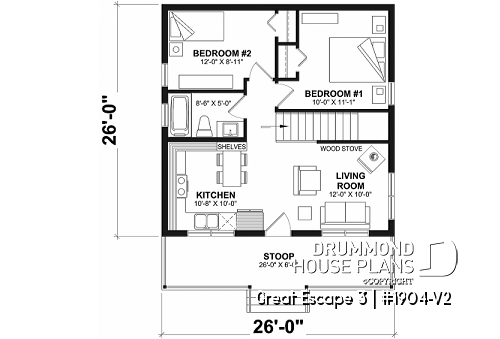
Simple Vacation House Plans Small Cabin Lake Or Mountain

Featured House Plan Bhg 7686

Floor Plan Affordable Orlando Vacation Home House Layouts Layout Plans

Gallery Of Vacation House Lm Architects 20

Rustic Vacation Homes Simple Small Cabin Plans Houseplans Blog Com


